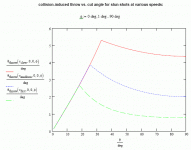Very nice diagrams, and some comments
Very nice diagrams, thanks for posting them.
On the left diagram, I'm not sure what the units are.
On the right diagram, which is very useful by the way, I believe that those lines should
really be less jagged. I have never seen anything in the domain of "pool physics" that
takes sharp deviations from a "natural flow". I am referring to the area between the 20
and 35 degree angle, for the medium speed. And, 45 degree point for the soft speed.
I realize how difficult it is to accurately obtain this data, and I commend you Bob for
your efforts. I would be interested in knowing for sure, if the "true" lines contain just
one curve as in the diagram on the right, or if there really is a dip near the end, as in
the diagram on the left. Anyway, this is great stuff, thanks again.
Very nice diagrams, thanks for posting them.
On the left diagram, I'm not sure what the units are.
On the right diagram, which is very useful by the way, I believe that those lines should
really be less jagged. I have never seen anything in the domain of "pool physics" that
takes sharp deviations from a "natural flow". I am referring to the area between the 20
and 35 degree angle, for the medium speed. And, 45 degree point for the soft speed.
I realize how difficult it is to accurately obtain this data, and I commend you Bob for
your efforts. I would be interested in knowing for sure, if the "true" lines contain just
one curve as in the diagram on the right, or if there really is a dip near the end, as in
the diagram on the left. Anyway, this is great stuff, thanks again.
